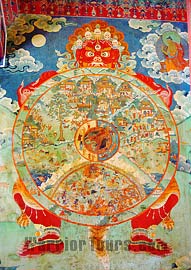- Potala Palace
- Barkhor Street & Norbulingka
- Ganden Monastery
- Jokhang Temple & Yangpachen
- Sera Monastery & Drepung Monastery
- Heavenly Lake Namtso
Sera Monastery & Drepung Monastery

![]() Sera Monastery
Sera Monastery
As one of the 'Three Great Monastery' of the Yellow Hat Sect, Sera Monastery is located at the foot of Tatipu Hill, some 3 kilometers (about 1.86 miles) north from Potala Palace. The monastery was originally constructed in 1419 by Sakya Yeshe, one of the disciples of Tsong Khapa who was sent to meet Emperor Yongle of the Ming Dynasty (1368 - 1644) on behalf of Tsong Khapa, and was entitled Dharma King of Great Mercy. Emperor Yongle also awarded him many sutras, statues of Buddha, frocks, silk as well as gold and silver by which Sakya Yeshe was able to build the Sera Monastery.

In the northeastern part of the monastery lies the four-storey Coqen Hall. It contains a square, an assembly hall and five Buddha halls. The statues of Maitreya and Sixteen Arhats can be seen here. The first wooden carving and painting sutra, donated by Emperor Yongle is another treasure to be found here. Sera Monastery has three Zhacangs (or tantric colleges). Sera Je Zhacang is also a four-storey building in which the Hynagriva, horse-headed demon-god, is worshiped. Ngagpa Zhacang was once the Coqen Hall of Sera Monstery. It manly consists of four Buddha halls, the residence of the Dalai Lama and Stupa-tombs. It was the place where monks both learned and practiced Tantra. The chanting hall of Sera Me Zhacang is truly remarkable, with resplendent and magnificent murals adorning every conceivable corner of the hall.
Sera Monastery is also famous for its Tantric teaching. Monks debate every afternoon in Debating Garden to practice their tantra. What's more, a rock not far away from Sera is the location where Tibetans make 'sky burial'. According to local tradition, the dead of the common people will be dissected and feed to birds, thus purifying their soul. In respect this local custom, visitors are not allowed to be present at the site.
| Admission Fee: | CNY 55 |
| Opening Hours: | 09:00 to 16:00 |
| Recommended Time for a Visit: | Two hours |
| Bus Route: | It costs 15 to take a taxi to go,but you can bargain with the taxi driver. |

![]() Drepung Monastery
Drepung Monastery
As the largest monastery in Tibet, Drepung Monastery covers an area of 250,000 square meters (about 62 acres) at the foot of Mt. Gambo Utse, some five kilometers (about 3 miles) west of Lhasa. Known as the most important monastery of Gelugpa, Drepung Monastery was built in 1416 and was the seat of five Dalai Lamas before the Fifth Dalai Lama moved to Potala Palace.
In the middle of Drepung Monastery lies the Coqen Hall. As the main structure of Drepung Monastery, it is supported by 183 wooden pillars. Thousands of thangkas and murals representing holy and mystical are on the walls. Statues of Buddha are vivid and delicate; the stupa-tombs of the third and fourth Dalai Lama are also resplendent and magnificent.

Another construction in Drepung Monastery, namely the Ganden Potrang was built in 1530 during the reign of the Second Dalai Lama. Since then, the third, fourth and fifth Dalai Lamas also lived and worked here. So Ganden Potrang was the political center at that time. Rare sutras, exquisite religious vessels, majestic statues of Buddha and beautiful murals are also well preserved. Ganden Potrang is comprised of three rows of buildings. The front courtyard is about 400 square meters (0.1 acre). Monks perform Tibetan Opera here annually during the Shoton Festival. During this time, monks of the Drepung Monastery also unveil giant thangka of Sakyamuni on Mt. Gambo Utse. Both pilgrims and visitors alike can enjoy and appreciate the religious atmosphere thoroughly.
There are also four Zhacangs (or Tantric College) in Drepung Monastery. Deyang, Loseling, Ngagpa and Gomang have trained many lamas for the Drepung Monastery, as well as the other monasteries of Gelugpa, with a majority of the most learned lamas graduating from here.
| Admission Fee: | CNY 55 |
| Opening Hours: | 09:10 to 12:00 |
| Recommended Time for a Visit: | Three hours |
| Bus Route: | The best way is to take a taxi which costs about 20 |

